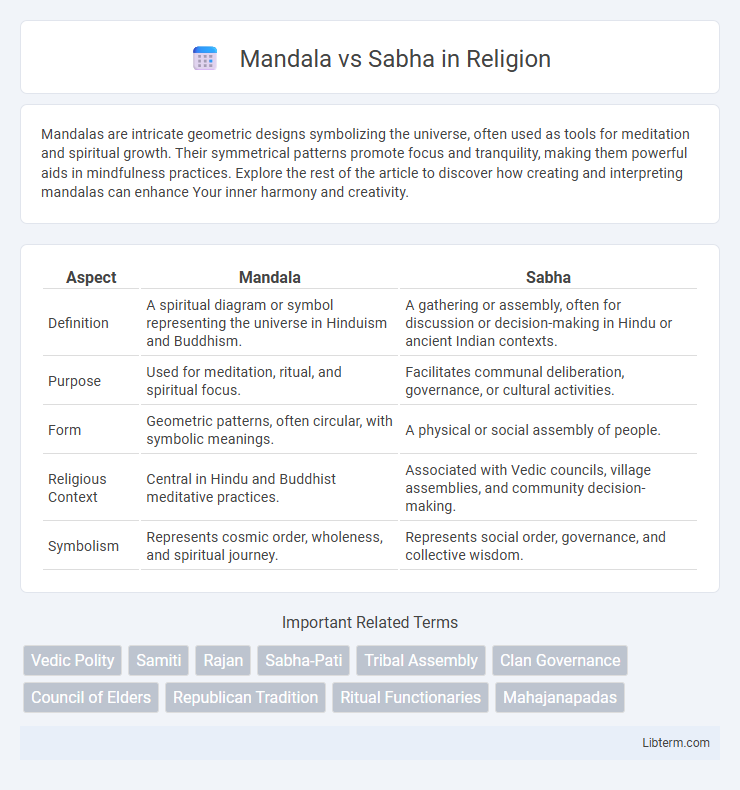Mandalas are intricate geometric designs symbolizing the universe, often used as tools for meditation and spiritual growth. Their symmetrical patterns promote focus and tranquility, making them powerful aids in mindfulness practices. Explore the rest of the article to discover how creating and interpreting mandalas can enhance Your inner harmony and creativity.
Table of Comparison
| Aspect | Mandala | Sabha |
|---|---|---|
| Definition | A spiritual diagram or symbol representing the universe in Hinduism and Buddhism. | A gathering or assembly, often for discussion or decision-making in Hindu or ancient Indian contexts. |
| Purpose | Used for meditation, ritual, and spiritual focus. | Facilitates communal deliberation, governance, or cultural activities. |
| Form | Geometric patterns, often circular, with symbolic meanings. | A physical or social assembly of people. |
| Religious Context | Central in Hindu and Buddhist meditative practices. | Associated with Vedic councils, village assemblies, and community decision-making. |
| Symbolism | Represents cosmic order, wholeness, and spiritual journey. | Represents social order, governance, and collective wisdom. |
Introduction to Mandala and Sabha
Mandala refers to the symbolic geometric design representing the universe in Hindu and Buddhist traditions, often used in meditation and rituals to promote spiritual focus and enlightenment. Sabha, in ancient Indian context, denotes an assembly or council where social, political, and religious discussions took place, shaping governance and community decisions. Both Mandala and Sabha hold significant cultural and historical value, with Mandala emphasizing spiritual realms and Sabha focusing on collective human governance.
Historical Origins of Mandala and Sabha
The historical origins of Mandala trace back to ancient Indian spiritual traditions, where it symbolized a cosmic diagram representing the universe and was used in meditation and ritual practices. Sabha, on the other hand, originated as an assembly or council in Vedic society, functioning as a platform for decision-making, governance, and communal discussions. While Mandalas emphasize spiritual and metaphysical concepts, Sabhas served a socio-political role in ancient Indian communities.
Etymological Differences
Mandala, derived from the Sanskrit word meaning "circle" or "discoid object," signifies a geometric configuration representing the universe or a sacred space in Indian traditions. Sabha originates from the Sanskrit root "sab," meaning "to gather" or "assemble," referring to an assembly or council often associated with governance or communal decision-making in ancient Indian society. The etymological distinction highlights Mandala as a symbolic, often spiritual, representation, whereas Sabha emphasizes a physical congregation or deliberative body.
Structure and Composition
Mandala refers to large political or administrative divisions in ancient Indian polity, typically consisting of multiple smaller units or kingdoms governed by a central ruler, emphasizing hierarchical and expansive territorial control. Sabha denotes a smaller, more localized assembly or council, often representing elite or council members within a community or kingdom, focusing on decision-making and advisory functions. The structure of Mandala is territorial and hierarchical, while Sabha is organizational and participatory, reflecting different layers of governance and social composition.
Functions and Roles
Mandala functioned as an administrative and territorial division in ancient Indian polities, with roles centered on governance, tax collection, and regional control. Sabha primarily served as a council or assembly responsible for legislative functions, decision-making, and judicial activities within communities. While Mandalas managed spatial and political organization, Sabhas facilitated participatory governance and social regulation.
Decision-Making Processes
Mandala and Sabha represent distinct decision-making processes in ancient Indian governance; Mandala emphasized a council of elders or chiefs exercising collective authority in tribal or regional matters, while Sabha functioned as an assembly with broader participation, often including a wider community or clan for deliberations. Mandala decisions were typically driven by consensus among principal members, reflecting localized political power structures, whereas Sabha incorporated advisory roles and advisory functions that influenced kingdom-wide policies and royal decrees. Both systems underscore the importance of participatory governance but vary in scope, membership, and formalization of their decision-making protocols.
Social and Political Significance
Mandala and Sabha represent distinct socio-political institutions in ancient Indian governance, where Mandala refers to a coalition of kingdoms or regional powers often centered around a dominant ruler, emphasizing territorial expansion and military alliances. Sabha functioned as a local assembly or council, typically comprising elders or respected citizens who deliberated on social and political matters, reflecting early democratic elements in village administrations. Together, these institutions highlight the dual nature of ancient polity: Mandala underscoring centralized authority and inter-kingdom relations, while Sabha embodied participatory governance and community decision-making.
Mandala and Sabha in Ancient Texts
Mandala and Sabha are key sociopolitical constructs mentioned in ancient Indian texts such as the Vedas and the Mahabharata. Mandala denotes a region or a territorial circle often referenced in geopolitical contexts, while Sabha refers to an assembly or council of elders responsible for governance and decision-making. Ancient scriptures highlight Mandalas as units of kingdoms or alliances, whereas Sabhas embody democratic deliberation and judicial functions in Vedic society.
Key Similarities and Differences
Mandala and Sabha both function as governing bodies in ancient Indian political systems; Mandala typically refers to a confederation of kingdoms or states forming a regional alliance for mutual benefit, while Sabha is a smaller assembly or council involved in local governance and decision-making. Key similarities include their roles in political administration, consultation, and maintaining social order, but Mandala operates on a larger, inter-kingdom scale whereas Sabha focuses on community or village-level management. The Mandala system emphasizes external alliances and military cooperation, whereas the Sabha centers on internal civic affairs, law, and dispute resolution.
Legacy in Modern Governance
Mandala and Sabha represent foundational governance structures that influenced modern political systems in South Asia. The Mandala system, characterized by a network of semi-autonomous polities centered around a dominant power, shaped diplomatic strategies and regional alliances still evident in contemporary federal governance models. The Sabha, functioning as an early form of assembly or council, established the precedent for participatory decision-making and the emphasis on collective deliberation found in modern parliamentary institutions.
Mandala Infographic

 libterm.com
libterm.com